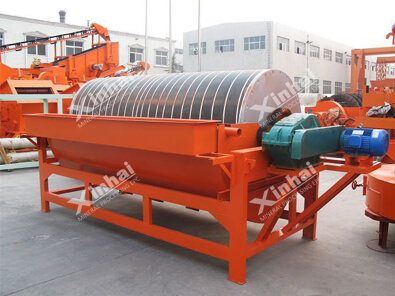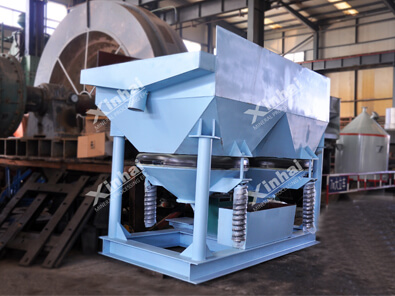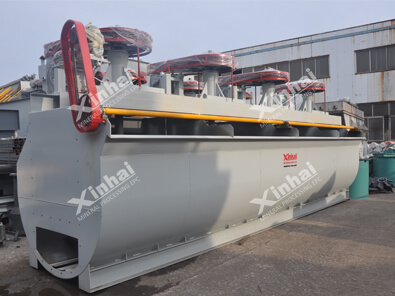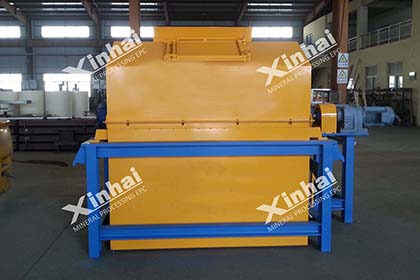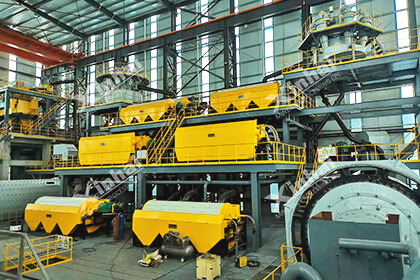Ultimate Guide | Extraction of Iron from Haematite
 Shirley
Shirley
 Oct 27, 2022
Oct 27, 2022
 1109
1109
If you want to know more details about equipment, solutions, etc, please click the button below for free consultation, or leave your requirements!

Haematite is a kind of iron ore, which is an oxide mineral of iron. With the increasing shortage of easy-to-separated magnetite in recent years, haematite has gradually become the mainstream of the iron ore market. We have introduced how to extract iron from limonite before, this article will introduce the haematite extraction process.
01Step1: Haematite crushing and screening stage
BackDue to the generally low grade and complex composition of haematite, three-stage open-circuit or three-stage-one closed-circuit are mostly used for crushing and screening. The common crushing process is coarse crushing-medium crushing-screening-fine crushing. The haematite beneficiation equipment in the crushing and screening stage is shown in the following table:
Crusher | Crushed Haematite Particle Size | Screening Particle Size |
Jaw crusher (coarse crushing, medium crushing) | 160 - 320 | — |
Gyratory crusher (coarse crushing) | 125 - 1450 | — |
Cone crusher (medium crushing, fine crushing) | 22 - 75 | — |
Circular vibrating screen | — | 0-12 |
Self-centering vibrating screen | — | 6-12 |
02Step 2: Haematite grinding stage
Back
Haematite grinding usually adopts autogenous mill (large-scale processing plant) or grid type ball mill + overflow type ball mill for wet grinding. The old ball mill is a center drive ball mill, which has high energy consumption. In recent years, a number of enterprises have developed energy-saving ball mills with peripheral rollers, and have renovated many old haematite dressing plants, and achieved obvious energy-saving effects.

03Step 3: Haematite separation stage
BackHaematite is widely distributed and involves many types of minerals. Therefore, the haematite extraction method is not single, and the following 8 processes are common.
1. Haematite single gravity separation process
According to the particle size of haematite minerals, it can be divided into fine-grained gravity separation and coarse-grained gravity separation.
Fine-grained gravity separation is to grind the crushed iron ore, dissociate its monomer, and then obtain fine-grained high grade red iron concentrate by gravity separation. The method is suitable for haematite with fine particle size and high magnetic content.
Coarse-grained gravity separation method is more suitable for coarse-grained haematite because of its coarse mineral size, so it mostly adopts only crushing without grinding method, and then discarding the broken coarse tailings by gravity separation.
2. Haematite single magnetic separation process
Single magnetic separation of haematite is mainly suitable for processing haematite containing non-metallic minerals. When the pulp enters the separation stage, the magnetic ore particles can be magnetized under the action of a non-uniform magnetic field. In this case, it will be attracted by the magnetic field, so that it is adsorbed on the cylinder and brought to the discharge end for discharge. The non-magnetic ore particles still exist in the pulp due to the small effect of the magnetic field.
3. Haematite all-flotation process
Haematite flotation methods are mainly two types: positive flotation and reverse flotation. The haematite positive flotation method is mainly suitable for processing the single haematite, and mainly uses anionic collectors to float the haematite from the original ore. The haematite reverse flotation method is mostly suitable for haematite with high grade and gangue easily floating. It mainly uses anionic and cationic collectors to float the haematite from the original ore.
The use of fatty acid anions as collectors and sodium carbonate as slurry regulators to flotate haematite in haematite-quartzite ores solves the problems of high slurry viscosity and difficult dewatering of concentrates.
4. Haematite strong magnetic-flotation process
The main feature of the haematite strong magnetic-flotation method is to discharge the gangue minerals such as single quartz and easily muddy chlorite in the ore under rough grinding conditions through strong magnetic separation to produce qualified concentrates. Thereby creating favorable conditions for further fine grinding and flotation.

5. Haematite roasting magnetic separation process
Roasting magnetic separation method is one of the effective methods to separate fine-grained to fine-grained (<0.02mm) haematite. When the mineral composition is complex, and other beneficiation methods are difficult to obtain good separation indicators, the magnetization roasting magnetic separation method is often used. The shaft furnace reduction roasting process of 75-20mm lump ore is mature and has long-term production practice experience, while the 20-0mm rotary furnace magnetization roasting production practice is less. For powder ore, methods such as strong magnetic separation, gravity separation, flotation and their combined processes are commonly used for separation.
6. Haematite roasting magnetic separation-reverse flotation process
Haematite roasting magnetic separation-reverse flotation method is mainly to improve the quality of roasting magnetic separation iron concentrate, using dodecylamine cation as collector to complete reverse flotation in neutral pulp.
7. Haematite strong magnetic separation process
The haematite strong magnetic separation method was put into operation, which solved the problem of dust and waste gas purification caused by roasting and the high energy consumption of about 100m3 of natural gas per ton of concentrate. The total energy consumption expressed in equivalent fuel tons is reduced from 0.202 for magnetization roasting to 0.054 for intensive magnetic separation, which is a significant progress in iron oxide quartzite beneficiation without roasting.
8. Haematite Stage grinding-gravity-magnetic-anion reverse flotation process
With this beneficiation method, under the condition that the metal recovery rate is not reduced and the original production capacity of the beneficiation plant is maintained, the iron concentrate grade reaches 67.14%, and the cost of beneficiation agents is reduced by 24.89%. The traditional roasting and magnetic separation process is eliminated, the energy consumption cost is reduced by 48.93%, the processing cost per ton of concentrate is reduced by 3.28%, and the personal safety and environmental pollution caused by the use of gas in roasting are also eliminated.
04Step 4: Haematite concentration and dewatering stage
BackAfter separation, in order to obtain the finished haematite concentrate, it needs to go through the process of concentration and dewatering.
Concentration: The haematite slurry is transported to the thickener through a slurry pump. The haematite particles in the slurry fall by gravity. After a while, a layer of mineral sludge appeared at the bottom of the concentration tank. At the same time, the rake at the bottom of the thickener moves the sediment towards the center of the bottom. The haematite precipitate exits the thickener for subsequent dewatering and filtration.
Dewatering: Disc vacuum filters are generally used to increase dewatering efficiency and reduce energy consumption. When the haematite concentrate slurry flows into the filter, the ore particles are adsorbed on the disc filter cloth under the action of the negative pressure formed by the vacuum pump. After a while, a filter cake of a certain thickness will form on the filter cloth. The pressure of the blower and scraper on the filter causes this filter cake to fall into the chute. The remaining filtrate will be drained from the central shaft. After that, the haematite concentrate product can be obtained.

(Hematite processing plant plan)
05To Wrap Up
BackThe above introduce how to extract iron from haematite. If you want to customize the haematite extraction solutions, you can contact the online service or submit a message, we will contact you soon.
 +86 18716000713
+86 18716000713 xlyin@xinhaimining.net
xlyin@xinhaimining.net




 Message
Message Chat Now
Chat Now


